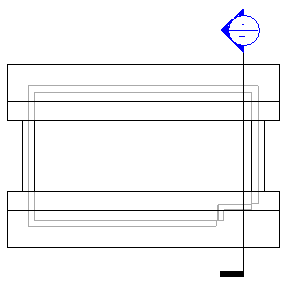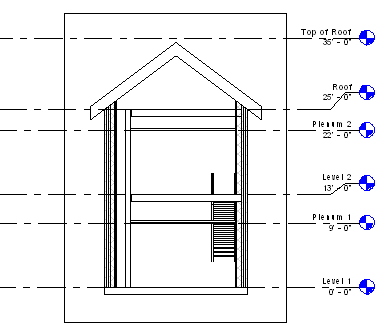This method places a space where its volume is constrained from a base level to the level above the roof. You use this topic when placing spaces for attics.
In the Project Browser, open the floor plan view that contains an attic area. Next, you create a section view to verify the space as you place it.
Create a section view
-
You can use an existing section view but make certain that the section line intersects the area in which you are placing the space. In the following examples, only one section view is needed because each level consists of a single space. You may need additional section views depending on the complexity of your design.
Note: Spaces do not display in elevation views.Place the section in the floor plan so that the section line intersects the area in which you are placing the space as shown.
- Double-click the section to open it.
Create the level above the roof
- With the section view active, click Systems tab
 Datum panel
Datum panel (Level).
(Level).
- Add the level above the roof.
Note: Make certain that the level is above the highest point of the roof.Note: Do not use the Plenum level type. This is a special level used for ceilings or plenums.

- Click Modify.
If you are using an existing level located above the roof, you can skip this section.
Activate spaces visibility
- Close all views, except the section view and the floor plan where you want to place the space, and type
w t on the keyboard to tile the 2 views.
You can also click View tab
 Windows panel
Windows panel
 (Tile Views).
(Tile Views).
- Click in the section view to make it active.
- Type v g on the keyboard.
- On the Model Categories tab of the Visibility Graphics dialog, scroll down to Spaces.
- Expand Spaces, select Interior and Reference (if you want to display reference crosshairs), and click OK.
- Repeat to make spaces visible in the floor plan view.
Place a space
- With the floor plan view active, click Analyze tab
 Spaces and Zones panel
Spaces and Zones panel
 (Space).
Note: You may need to load space tags in the project, if they are not already loaded.
(Space).
Note: You may need to load space tags in the project, if they are not already loaded. - On the Options Bar, do the following:
- For Upper Limit, specify the level above the level roof.
- For Offset, enter
0' 0" (0.00 mm).
These 2 options specify the vertical extent or height of the space.
Note: If the upper limit and offset are specified beyond the level above the roof, the vertical boundary of the space will snap to the roof, even though the upper limit is higher than the roof. This is because with the Areas and Volumes option selected (default setting), the vertical boundary of the space will snap to room-bounding components, such as roofs. The volume of the space will be calculated up to the room-bounding component. The Areas and Volumes option is located on the Architect tab Room & Area panel drop-down
Room & Area panel drop-down Area and Volume Computations.
Area and Volume Computations.
- In the Space box, either verify that New is selected if placing a new space, or select an unplaced space from the list to place it.
- Tag on placement: Places a space tag upon placement of the space.
Tag on placement is selected by default. If Tag on placement is selected, you can select the tag type from the Type Selector.
- Tag location box: specifies either Horizontal, Vertical, or Model as the space tag location.
Applicable only if Tag on placement is selected.
- Leader: Creates a leader line for the space tag.
Applicable only if Tag on placement is selected.
- Show Bounding Elements: Highlights the room-bounding elements in the building model for immediate recognition.
Select the following options as needed
- In the floor plan view, move the cursor over an area in the building model, and click to place a space.
Note: Spaces can only be placed in floor plan views.
- Click Modify.
- Select the space.
- On the Properties palette, under Energy Analysis, do one of the following:
- Select Occupiable, if the space will be occupied.
- Clear Occupiable, if the space will be unoccupied.
- Click OK.
Note: If you place a space in an area that contains a room, the Occupiable parameter is automatically selected. This defines the space as occupied. If the area does not contain a room, the Occupiable parameter is automatically cleared. This defines the space as unoccupied. You can always redefine the space by selecting or clearing this parameter. The Occupiable parameter affects the Systems Analysis.
- In the section view, verify that the shaded area representing the volume of the space is constrained from the base level to the roof, and that unshaded areas (caused by such things as cavities or shafts) do not exist. This provides for a more accurate volume calculation.

- If the space is not constrained as specified, in the section view, verify that the upper limit of the space is specified to the level above the roof, and
redefine the space vertically, if necessary.
You must also resolve all unshaded areas.